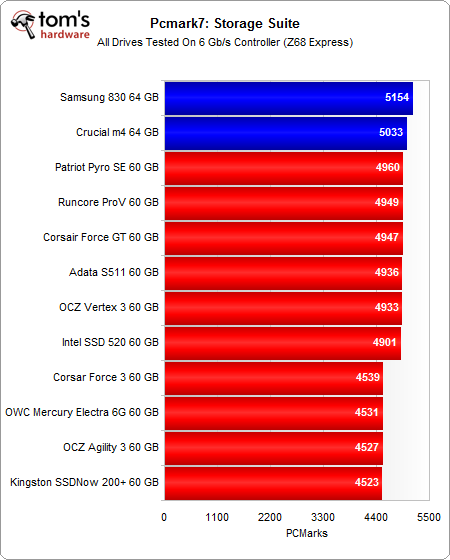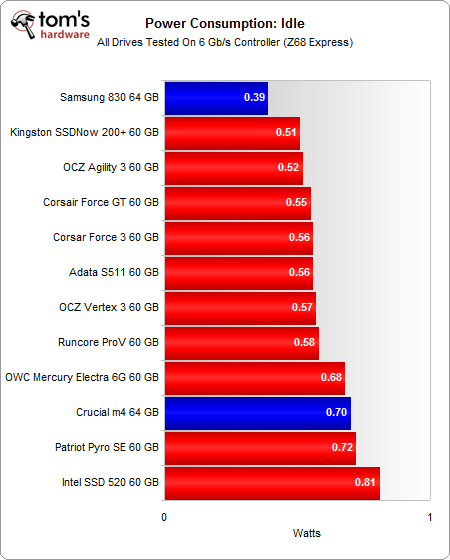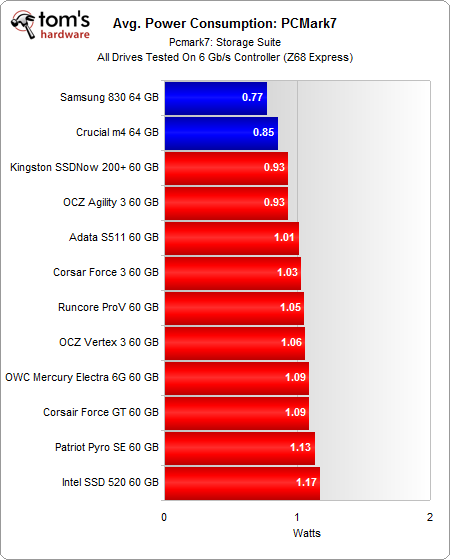Ten 60 GB SandForce-Based Boot Drives, Rounded-Up
PCMark 7 And Power Consumption
PCMark 7
Samsung’s 64 GB 830 jumps to the top of our PCMark 7 chart, followed by Crucial's 64 GB m4.
The SandForce-based drives don't do as well since this test consists of both compressible and incompressible information. The resulting workload isn't a best-case reflection of what its controller hardware can do. We do, however, see a very clear break between the drives with synchronous memory and the less expensive models equipped with asynchronous flash. On average, the faster SandForce-based SSDs deliver about 8.5% more performance than the more value-oriented models.
Power Consumption
Because SSDs are so fast, they sit idle most of the time. In our almost 30-minute virus scan, the SSD is only busy for 281 seconds. As a result, idle power consumption is the most important figure to consider in a desktop environment.
Samsung's 64 GB 830 does exceptionally well here. Even though it employs a beefy triple-core ARM-based controller, it consumes slightly less power than Crucial's m4 and its dual-core ARM-based Marvell controller.
When it comes to the SandForce-based drives, our results are less consistent than we might have expected. Though, with all of these sub-1 W measurements, we're not certain any of these SSDs can claim an advantage.
Get Tom's Hardware's best news and in-depth reviews, straight to your inbox.
Samsung continues to excel, even under more of a load. Its 64 GB 830 uses less power when it's active than Intel's SSD 520 at idle. Crucial's m4 takes a second-place finish, which is interesting in light of its less impressive finish in the idle chart.
There's again some variation between the SandForce-based drives, with no discernible trend in the finishing order. But we're still hesitant to flag a victor, given a fairly narrow range.
Current page: PCMark 7 And Power Consumption
Prev Page Incompressible Sequential Write Performance: SandForce's Weakness Next Page Endurance Testing-
mayankleoboy1 As these drives are basically boot drives, i would have liked a test where you measure the total time taken to install a fresh wi7-sp1 on it and install updates and install a few softwares likeReply
Ms-Office
Adobe pdf reader
a web browser, a photo manipulating program
a music/video player.
Install a game from a ISO.
An antivirus
And all these apps should be installed from the SSD itself (meaning their setups should be on the SSD).Then you should test the startup and shutdown times.
All these synthetic benchies dont make much sense, IMHO.
-
mayankleoboy1 I have found that when working with SSD's, single core CPU performance becomes a big bottleneck in some tasks.Reply
A lot of operations use only a single core and the SSD cant use its true potential. That is, the CPU cant process data as fast as the SSD can provide.
This is just reverse of what happens in case of mechanical HDD's. -
acku http://www.tomshardware.com/reviews/ssd-520-sandforce-review-benchmark,3124-14.htmlReply
You're not going to see a major difference. -
phamhlam mayankleoboy1I have found that when working with SSD's, single core CPU performance becomes a big bottleneck in some tasks.A lot of operations use only a single core and the SSD cant use its true potential. That is, the CPU cant process data as fast as the SSD can provide.This is just reverse of what happens in case of mechanical HDD's.Reply
Well, it is pointless though since everything you are doing is so fast that it doesn't matter anymore. I however see your point since I can be loading a program and my SSD is not even at max speed my CPU frequency is maxed out. The only way to get more speed is to just overclock as much as you can. -
mayankleoboy1 ackuhttp://www.tomshardware.com/review 24-14.htmlYou're not going to see a major difference.Reply
that is the point of buying a cheaper SSD based on a chepaer NAND.
-
compton Considering the conclusion that performance is defined by flash, I find it interesting that the one SF2281 with Toggle NAND at 60GB is not in the roundup (in North America anyway). The Mushkin Chronos Deluxe 60 is substantially cheaper now at $99. It's performance characteristics are much more profound than the 25nm ONFI sync/async models. They're often out of stock at Newegg, and for good reason.Reply
-
clownbaby Is there a benchmark to compare virtual memory performance? My current workstation has 24gb of memory, which means Windows eats up 36gb of my boot drive for virtual memory. (yes, I know I can change/disable it, but some programs act wonky when it's screwed with). A dedicated virtual memory drive would free up space on my primary ssd, as well as keep the writes down.Reply
I'd also like to see small drives benchmarked as swap drives in video editing machines. Currently I'm using a raid 0 array of 1tb samsung drives that keeps up well enough, but I'd be interested to see if there are tangible productivity differences. -
JackNaylorPE With a final page heading "Performance Is Defined By Flash" I would have like to see that difference looked at more closely. For example, the Mushkin Chronos Deluxe uses premium 3Xnm Toshiba Toggle Mode Flash (as does Patriot Wildfire, Vertex 3 Max IOPS and OWC Mercury Extreme Pro) and I would love to see for example how just changing the Flashin in an SSD from the same manufacturer and line (i.e Chronos standard versus Deluxe, Vertex 3 versus Vertex 3 Max IOPS). With that info, a user can decide whether it's makes sense to invest in say the premium Toshiba stuff as compared to the "same SSD w/o the premium Flash. That was what I expected to see when I read the referenced page heading.Reply -
jsowoc I'm wondering why Toms' own trace-based benchmark didn't make it into this round-up? Does it take much longer to run than the other tests? While comparing synthetics is important to determine why a certain drive behaves a certain way, trace-based benchmarks (PCMark 7 could be considered trace-based) is what makes the final purchasing decision. In this case, PCMark was the one with the most clear-cut differences, ones that would likely be mirrored in a trace-based benchmark.Reply
For a future SSD review/roundup could you take, for example, 10 real-life traces from 10 different editor's machines (the more variation in workload, the better), and then compare the %change in execution time vs. a reference drive?


